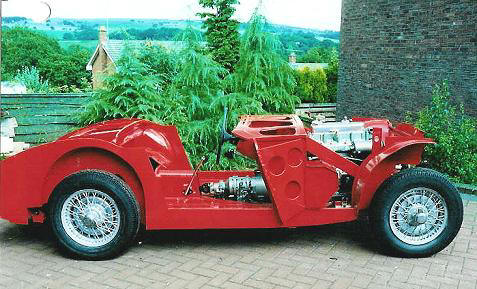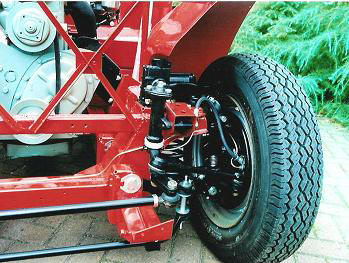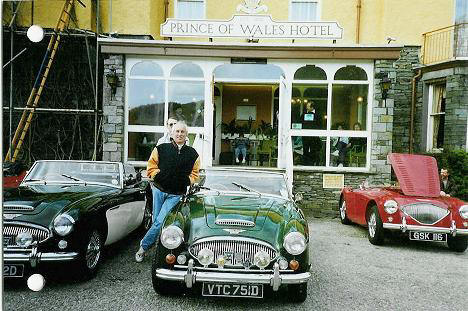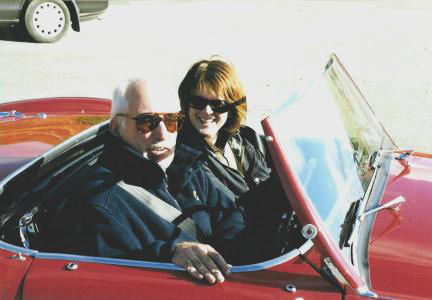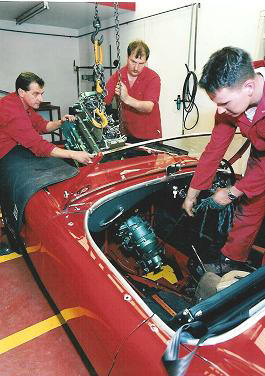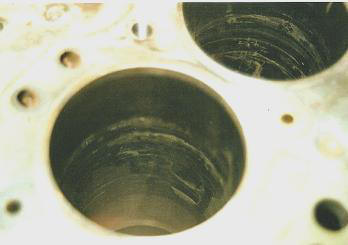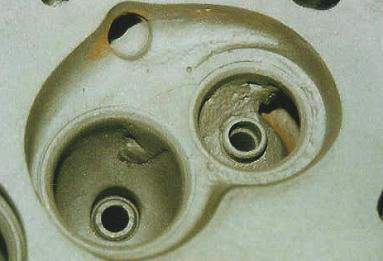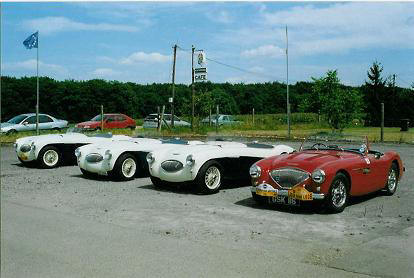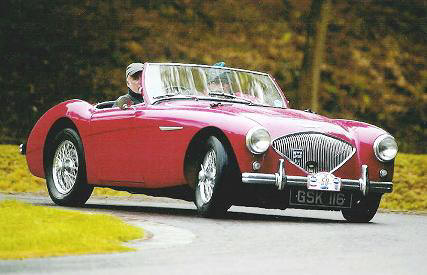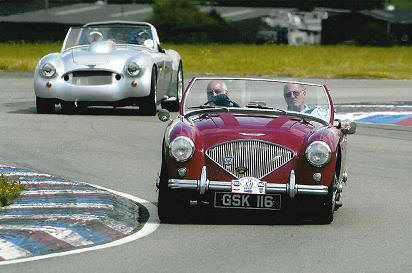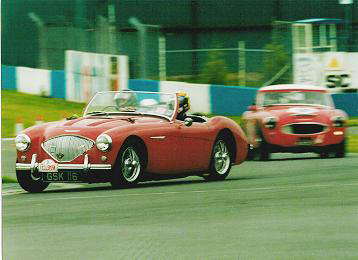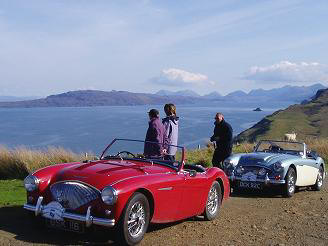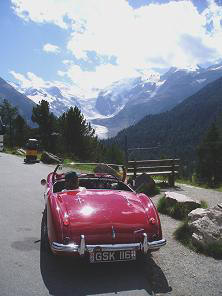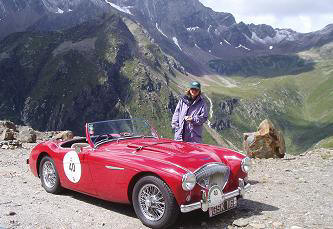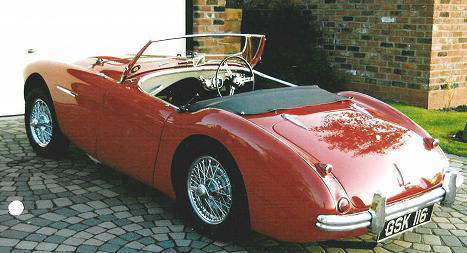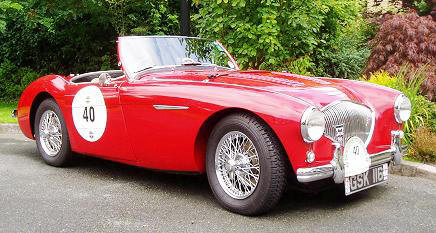- Members Motors
- Index
- John Ridyard
- Denis Austin
- Ivor Davies
- Robert Thornburrow
- Ivor Davies part II
|
GSK 116, AUSTIN HEALEY 100, BN2, M-REPLICA Mike (Smith, our illustrious Northern Centre Web Master) has been chasing for more articles to enter in the "Member's Motors" section of our Web Site for some time now and has eventually persuaded me to write this article chronicling my ownership of GSK 116. Part of my initial reluctance was rooted in the fact that, having read the articles written by our Chairman, John Ridyard, and our former Director, Denis Austin, I felt a little in awe of their respective automotive skills, especially those of Denis when one considers his considerable disadvantage, and rather ashamed to admit that GSK has little to do with my skills other than my limited accomplishments with the spanners and my ability to pay for the many bills which accompany the privilege of classic car ownership. Still I suppose my experiences relate to a different side of classic car restoration and ownership and give another perspective on the whole business, so here goes. |
|
|
|
Austin-Healey BN2 - L/230115 is shown by its Heritage Trust Certificate as have been built in December 1955 and exported to the USA in left-hand drive form with Healey blue paintwork, blue trim, a heater and a laminated windscreen. Its' history in the USA is completely unknown, by me at least unless our American friends can offer any information, until, in 1989, it was repatriated by dealer George Holt of Blackpool. It was apparently in a rather sad condition but was purchased early in 1990 as a "runner" by Jim Marland, the then proprietor of Proteus Cars of Bolton who used to manufacture rather fine Jaguar C and D type replica cars in kit or fully-built form, and even built replicas of the Jaguar XJ13 and the Moss-Jenks Mille Miglia Mercedes 300SL. The car became his personal restoration project and the rebuild was chronicled in Jim's article in Rev Counter or was it in Torque of the North, the Northern Centre magazine, in 1992. |
|
In that article he stated "in January 1990 I found myself handing over a small fortune in exchange for a very dubious metallic blue example (of the Austin Healey 100) imported from Texas complete with bullet holes". Do the bullet holes narrow down its' presumably chequered history any? The most notable aspects of the complete nut and bolt restoration as detailed in that article are that the car was converted to right-hand drive and the bodywork was restored, fitted and painted not once but twice by Road and Race Restorations of Little Hulton, Greater Manchester, firstly in Colorado Red and then again in Reno Red because Jim changed his mind having seen a Reno Red 100 at the 1990 Northern Centre Lakes Weekend at Cartmel. Standish Car Trim trimmed the interior in beige leather with red piping and the car was fitted with a louvered aluminium bonnet. The axle, gearbox and presumably overdrive rebuilds were carried out by Hardy Engineering and the engine rebuild was by Rally Equipe of Bury (more of them later!) to M-specification but with standard rather than high-compression pistons. A notable comment in the article was that "The engine which had "been done" by the previous owner needed everything that an engine could need". One feature of the rebuilt car that I particularly like is the non-standard black crackle-paint finished dash panel that Jim made himself. |
|
|
|
|
|
The car was registered as GSK 116 in May 1991 and it won an award for the "Best Overall" at the Northern Centre Lakes Weekend that year. At that time I owned VTC 951D, a British Racing Green A-H 3000 BJ8 that I purchased, as my first foray into classic car ownership, from AHC member John Newton of Llandudno. It was that car that chauffeured Pam and I and our daughters Caroline and Kate to the "Lakes" event in 1992 where we met the Marlands and their pristine "new" 100. The Heathcote Trophy for the Best 100 at the Northern Centre May Bank Holiday Weekend currently sits in my study window, GSK having been favoured again this year, and the first winners' shield on that trophy is engraved to Jim and GSK at the 1992 event. |
|
|
|
|
|
In September 1992, having received a small windfall from my business, I convinced myself that it would be best invested in another classic car. That conviction, which was leading me towards a suitable "100", coincided with Jim Marlands' expressed intention to sell GSK. Pam didn't object too strongly. In fact she was very encouraging throughout the whole purchase process, and, egged on by several of my by-now friends in the Healey Club, I closed the deal with Jim for a considerable sum and became the proud owner of a second Healey. I have to say the VTC was very gracious in his acceptance of a competing Healey in his garage and never once gave me any grief over the matter, but you can only drive one at a time and gradually my preference favoured GSK. I suppose it was a combination of factors that confirmed my final choice. I have never really liked red cars yet for some reason my 100 looked exactly right to me in Reno Red and the deep red along the classic flowing body lines proved irresistible. The size of the car and its' driving layout just seem to suit my size and driving style and I prefer the more period feel to the whole driving experience in the "100" as compared to the more modern and better equipped "3000". So in 1997 I bowed to the inevitable and sold VTC to a Mr. T. Wheeler of battle, East Sussex. I have not seen or heard of the car since but I hope he is enjoying it as I did. |
|
|
|
And so to my custodianship of GSK 116. I have owned her for just over twelve years now and I still get a buzz when I look at and drive her. But it hasn't all been plain sailing and I have to admit that I have experienced most of the pitfalls that classic car purchase and ownership has to offer. The bodywork and panel fit remain on the whole in very good condition, although the car has been with Phil Kennedy of Renaissance Classic Car Co. Ltd., an Austin-Healey restorer from Hednesford, last summer to have one or two bits of bodywork repairs carried out; albeit mainly to rectify damage inflicted by myself (a couple of dents and a flattened sill) but also to repair an ever-expanding crack in the front shroud. It was during that repair that Phil showed me the potential difficulties in matching the paintwork on classic cars, especially red ones, and he painted the shroud three times before he was fully satisfied with his work. Needless to say I am more than happy with the repairs that he carried out. The general quality of the original body restoration was and has remained very good and I have few complaints in that department. However, sorting the car mechanically has been a very different story; difficult, very frustrating at times, and very expensive. |
|
Despite the previous owner having apparently thrashed some impressive displays of speed out of her, I was less than happy with the performance. The problem is, of course, that unless you know the individual car or have extensive knowledge of the range of "100" performance, you have no benchmark against which to make assessments. I didn't have that experience but after three years of questionable performance, very high fuel consumption at only 15 mpg, and almost constant lack of tune manifesting itself in misfiring, hunting and reluctance to start when hot, I finally bit the bullet and joined John Ridyard on a trip to the Northern Healey Centre in Castleford. There Paul Grogan put both our cars on the rolling road. John's BJ8 came away in perfect tune and mine stayed for an enforced holiday. |
|
|
|
Paul was bemused by the fact that the power output at below 70bhp was very low and there were no improvements to be gained from either ignition or carburettor tuning. He tested the compressions and found a variation from a worst of 120 to a best of, and still very poor, 138psi. Reluctantly we came to the conclusion that the work in rebuilding the engine as claimed and billed by Rally Equipe could well have some serious shortcomings. A month late and a fairly horrendous amount of money lighter I collected GSK from Castleford, now with a proper engine to full M-specification. The stripdown revealed the cylinder head to be total scrap. There was a crack between the valve seats on number one cylinder that had seen a totally inadequate botched welded repair, and irretrievably-pitted valve seats on all four cylinders. In addition, despite the alleged rebore, there was severe corrosion "water" marking in all four cylinder bores and it appeared that the reboring had been stopped after the first oversize when in fact a second rebore was necessary to remove the imperfections. |
|
Most of the ancillaries on the engine seemed, by inspection and by association with the general standard of the rebuild, suspect as well, so the engine rebuild was commenced from scratch. It was first necessary to find a serviceable second-hand cast-iron cylinder head and one was sourced from another American import car. I would have preferred at that stage to have fitted a new aluminium head but, despite several firms advertising these for sale, my enquiries revealed that they were really only drumming up business to take orders for future machining and delivery and, as I could not countenance the long waiting period, the cast iron head was purchased and the rebuild undertaken. |
|
|
|
Suffice it to say I still feel aggrieved about the whole matter of my scrap engine, especially since the car was purchased as a concours example with all bills to support the total project including the engine rebuild to commensurate standards. Because of the time elapsed between my purchase of the car and my discovery of the defects I have never considered initiating a legal claim for recompense but I still wonder, having re-read the section of Jim Marlands' article concerning the engine rebuild and re-examined Rally Equipes' invoice, whether the responsibility was Rally Equipes' or whether they were working down to a limited budget for their client. Either way I was the looser and there is a lesson to be learned from the experience. But when the car was tested again on the rolling road after the rebuild it produced a healthy 120bhp at the flywheel, which equates to 101bhp at the wheels, and that has proved to be quite powerful enough for me. Because of the amount of metal removed from the head to accommodate larger valves and improve the gas flow, it was not possible to fit hardened valve seats once legislation to abolish lead additive in petrol was introduced. Hence, after reading all the appropriate literature, I chose to run on standard four-star unleaded petrol with STP Lead Substitute and Octane Booster. |
|
|
|
|
Apparently the degradation of valve seats through lack of lead or a suitable substitute in the petrol varies greatly depending on driving style and the efficiency of the additive but, touch wood, GSK has travelled over 20000 miles on this fuel mixture since the rebuild and a recent compression test, showing just over 180psi on each cylinder, seems to indicate that all is well. After the rebuild, despite the dramatic increase in performance, the fuel consumption improved to a much more acceptable average of 24mpg. As well as the full M-spec rebuild on the engine, including this time the flat-top high compression pistons, I have subsequently treated the engine and its environs to several Denis Welch performance parts. These include, in no special order, a spin-on oil filter, an oil cooler, a narrow fan belt conversation, a concealed cone air filter, an aluminium sump, a flexible oil feed pipe, a five-bladed plastic fan, a pre-engaged starter motor, new inlet manifolds, a large heat shield (fitted in tandem with the original, smaller heat shield), an accelerator cable, an up-rated clutch operating linkage, and, to keep the whole lot cool in an emergency, a Kenlowe fan. In the electrical department the car has two small Varta 12-volt batteries, which sit on the trays as the original 6-volt batteries, but which, of course, are wired in parallel. It is converted to negative earth, has a pointless electronic fuel pump, a sports coil, and Lumenition Optronic electronic ignition with a Rev-Limiter to protect my cast-iron crank from the consequences of over exuberance. As with the engine performance, I was less than enamoured with the general stance of the car. I always noted that it appeared to "stand up" at the front and I had reasoned this to be due to the cut-away wings fitted to the BN2 models. However, the more I drove her and the more I clattered the rear-discharge exhaust on anything other than billiard-table flat tarmac, the more convinced I became that the springing was the problem. Hence the car now has Denis Welch 8-leaf rear springs and competition front springs together with an offset trunion bush set, and a competition front anti-roll bar. It also has a bespoke side-discharge exhaust made by Tube Torque of Macclesfield. The result of these suspension modifications was immediately dramatic in that the car was leveled to sit square all round, holds the road much better, and misses all but the largest bumps and depressions. |
|
|
|
And finally to the brakes. GSK was fitted with the correct, wider front drum brakes of a BN2 and whilst I had no complaint about the power of the braking, I was less than confident in the stability of the car under heavy braking especially in emergency conditions. My mind was made up when, on returning from a rally in Scotland, I had cause to brake hard on a motorway to avoid an errant Mercedes, and I immediately swapped lanes. Fortunately I did not hit anything and everyone missed me but the seeds of doubt had been sown. GSK now has a Denis Welch front disc brake conversion fitted together with the necessary smaller rear brake cylinders, and the braking is, if anything, a little too good. The braking power now exceeds the grip of the tyres and it is easy to lock the front wheels if the drivers' concentration is wandering. |
|
I have now driven just over 25000 miles in GSK and each year we seem to travel just a little further that the last. I have just been forced to buy a new set of boots but at 25000 miles I can't grumble, especially the way I drive and the number of track sessions we have done. The car has always worn Michelin XZX 165SR15s on 4J, 48-spoke, chrome wire wheels. To me they look just right. The tyres must be as hard as concrete but I find they suit the car, or at least my style of driving it, perfectly. Despite at one time hankering for some 185 tyres (Avon ZZs are the ones to have say the fast boys) on 5J, 72-spoke wires, I have now decided to keep the look of the car as original and standard as possible. As I say I like to slide the car and, with such hard and narrow tyres, this fun is available at relatively low and almost legal speeds (an important consideration these days with ever-increasing pressure on our licences). I justify my decision by thinking that Healeys were never designed for modern sticky rubber and that the extra grip that would be gained would inevitably result in unanticipated strains on the suspension. I have had problems with my wheels and was forever popping spokes on the rears. This was cured by fitting, at almost the same cost unfortunately as new wheels, stainless steel spokes in the rear wheels (by SAS at Macclesfield). These were fitted over 15000miles ago and I haven't had a recurrence of the problem since. With the bumpers still in-situ the car looks very standard but she goes a lot better than standard, I think. |
|
|
|
|
|
The only external giveaways are the aluminium sump guard, the front disc brakes, and the side-discharge exhaust. The sump guard annoys Pam enormously because it grounds at almost every severe undulation in the road (and wakes her up). The suspension set-up is so good that, before fitting the guard, the car hardly ever grounded, but when she did I always feared for the sump and the chassis. I took it off before going to Switzerland this year and noted that it was split in the centre. That damage must have occurred on the rough roads of Scotland on the 2003 Highland Three-Day or the 2004 Chasin' the Haggis Tour, but I reasoned that the continental roads would be smoother - and they were. We only grounded once and that was on the ferry ramp at walking speed. Phil Kennedy noted my belt-and-braces approach in having an aluminium sump and a sump guard fitted, but I prefer to be sure. |
|
|
Oh, and before I forget, I have removed the hood from the car and currently have no intention of refitting it. The difficulty of erecting the hood (I don't know whether it was just my hood, but I always used to get the stays jammed and crossed up, or the rivets broken despite taking considerable care) used to frustrate me and then, with the hood erected, the limited vision used to frighten me at times in heavy traffic. So, for two or three years now, we have carried wash leathers and sponges to clear the inside of the windscreen, towels to mop up the wet spots, and two umbrellas to protect us when we have to stop in heavy rain. We also wear fully waterproof clothing and find that, at normal driving speeds, we actually get no wetter than we used to when traveling with the hood up. We also win a small amount of extra, valuable storage space behind the seats where the hood used to be. During our recent Swiss trip there were times when a refitting of the hood was considered but, so far, it has stayed, stored in the garage. |
|
|
|
Well that is the history of GSK 116, with me. Unless something dramatic happens to make me (and Pam) change my long term plans, and as long as GSK is thinking along the same lines, GSK and I are thinking of growing old gracefully together. She is actually ten years younger than me and, some would say, wearing better! We attended the first European Healey Meeting in Luxembourg in 1999, where GSK won a third place in the Modified Big Healeys class of the concours, and the 50th Anniversary Meeting in Reading in 2002. We have been around Scotland on several occasions with the Highland Three Day and Chasin' the Haggis Tours and our horizons are slowly expanding (not like my waist-line, you wags). |
|
Our trip to the 2nd European Healey Meeting in St. Moritz this summer was superb although I have to say that whilst GSK put in a sterling performance it was not trouble free. Just before the event, on the advice of Phil Kennedy who was convinced that my car was in need of the attentions of an accomplished tuner, I took GSK to the rolling road of Lester Owen in at Telford. My previous rolling road test had been in 1998, three years after the engine rebuild, at the Northern Healey Centre. I would have preferred to take it back there but unfortunately the rolling road facility that Paul Grogan used had closed and, whilst he has acquired the equipment for installation in his workshop at Willowbridge Garage, that installation will be for some time in the future, some time away yet. I needn't have worried about the credentials of Lester Owen though. Whilst passing away the time during one of my two visits there I spotted a Ferrari V12 engine in a corner of the workshop. I was informed that this was the original engine from the 250 GTO as driven by Scarfiotti currently owned by Anthony Bamford and raced by his son Joe. Apparently Lester Owen had recently rebuilt and tuned the "spare" engine which is used to save any possibility of damaging the original engine and hence the historic value of the car. If the credentials are good enough for the heir to JCB I am sure they are good enough for my little Healey and me. I came away from Telford with a car in perfect tune but with slightly mixed feelings. The work certainly saved my trip to Switzerland because the distributor needed a complete modification and rebuild and would not have made the ferry in its former state. It also saved us a small fortune because Lester Owen put larger needles in the carbs and leaned the mixture to the extent that our overall average fuel consumption for the trip was an amazing 28 mpg. In fact is was embarrassing how little we had to put in compared with our BJ8-mounted travelling companions. But in another way it raised some questions because the power output on the rolling road was only 88 bhp at the wheels and not the 100 bhp that I was hoping had been maintained since my previous rolling road test some six years earlier. In addition the leaner mixture caused an increase in the running temperature that was no problem on the run but that caused concern as soon as we were stopped in traffic when the temperature soared to dangerous levels. One of these questions has been answered and the other problem will be resolved this winter. |
|
|
|
|
|
During the Swiss trip, on the Stelvio Pass in fact, my clutch started to make funny noises. To cut a long story short I made it home with little or no clutch left, nipping in to Castleford on my way passed to book in for the necessary repairs. She is now back home with a new clutch together with new wheel bearings all round and a new rear hub (the old bearing had been glued into a defective hub, had worked loose, and was spinning). Whilst she was with Paul I also got him to check the compressions and the condition of the plugs, and to hook the exhaust up to the gas analyser. The results showed that the tuning work carried out in Telford was perfect in that the carb set up and the fuel burn were both spot on. The compressions were tested to be as good as could be expected and I have to say that in my own mind I am convinced that GSK is still as powerful and she was immediately after the rebuild. So I know she is in prefect tune and mechanical condition. The only outstanding requirement is to fit a new, modern core to the radiator in the hope that this will cure the tendency to overheat. I have found the man to do the job and this will probably be completed in November. But, no doubt my next trip to the NEC Classic Car Show will throw up another "want". |
|
|
|
|
|
Ivor Davies October 2004 |
|




